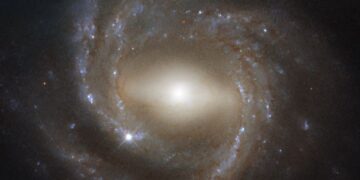When it comes to understanding the universe, every observation and hypothesis adds a piece to an intricate cosmic puzzle. Recently, NASA’s Hubble Space Telescope delivered a stunning image of NGC 7773, a barred spiral galaxy, revealing intricate details of galactic evolution. Simultaneously, researchers are exploring the fascinating concept of “fuzzy” dark matter, a revolutionary hypothesis that could redefine our understanding of dark matter and galactic cores.
NGC 7773: A Portrait of Galactic Maturity
A Glimpse Through Hubble’s Eyes NGC 7773, a barred spiral galaxy, stands as a testament to the universe’s complexity. Captured by Hubble’s Wide Field Camera 3, this galaxy features a luminous bar cutting through its bright core, bordered by graceful spiral arms. The bar, characteristic of older spiral galaxies, plays a significant role in directing star-forming material toward the galactic center.
Studies of galaxies like NGC 7773 illuminate the processes of star formation. The galaxy’s bar acts as a stellar nursery, filled with youthful, radiant stars, offering astronomers clues about the life cycle of galaxies.
Parallels with the Milky Way Interestingly, our Milky Way shares structural similarities with NGC 7773. Both are barred spirals, which means studying NGC 7773 allows researchers to reflect on our own galactic history.
Unraveling the Fuzzy Dark Matter Hypothesis
The Shortcomings of Traditional Models For decades, physicists have believed dark matter to be cold, massive particles that interact weakly with normal matter. While this hypothesis explains much of the universe’s behavior, it struggles with the densities observed in galactic cores. The centers of galaxies appear less dense than predicted by traditional dark matter models, posing an intriguing challenge.
What Is Fuzzy Dark Matter? Fuzzy dark matter introduces a groundbreaking idea: dark matter particles may be incredibly lightweight and exhibit wave-like properties on a macroscopic scale. These particles form diffuse clumps known as “dark stars,” which could account for the less dense cores of galaxies.
Recent simulations support this hypothesis. Researchers modeled interactions between fuzzy dark matter and normal matter, revealing a natural equilibrium that stabilizes galactic cores.
The Role of Technology in Linking Observation and Theory
How Hubble Helps Decode Galactic Mysteries The Hubble Space Telescope’s ability to capture fine details of galaxies like NGC 7773 provides invaluable data. Its high-resolution imagery allows scientists to identify features such as bars, star clusters, and structural alignments, all of which are essential for testing theories about galactic evolution.
Simulations: The Other Half of the Equation While telescopes provide visual confirmation, computer simulations bring theoretical ideas to life. Simulations of fuzzy dark matter demonstrate how it influences galactic behavior, showing potential connections between theoretical models and real-world observations.
Implications of These Discoveries
Shedding Light on Galactic Evolution NGC 7773’s detailed image offers a snapshot of how galaxies evolve over billions of years. Observing such structures provides context for understanding how galaxies mature and sustain star formation, critical for life as we know it.
Redefining Dark Matter If the fuzzy dark matter hypothesis holds true, it could revolutionize cosmology. This model not only explains observed densities but also opens new avenues for studying the universe’s earliest structures. Understanding dark matter’s nature could also illuminate the formation of stars and galaxies.
A Broader Perspective on the Universe These discoveries remind us that our understanding of the cosmos is constantly evolving. By bridging observations with simulations, scientists are piecing together a more complete picture of how the universe operates, inspiring future research and technological advancements.
Conclusion: Exploring the Unknown
The discoveries surrounding NGC 7773 and fuzzy dark matter exemplify the dynamic nature of astronomy. As we delve deeper into the mysteries of galaxies and the forces shaping them, we come closer to answering fundamental questions about the universe. The interplay between cutting-edge technology, innovative theories, and awe-inspiring observations ensures that the journey to understanding the cosmos remains as thrilling as ever.



















